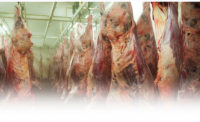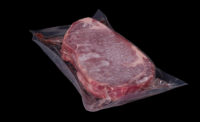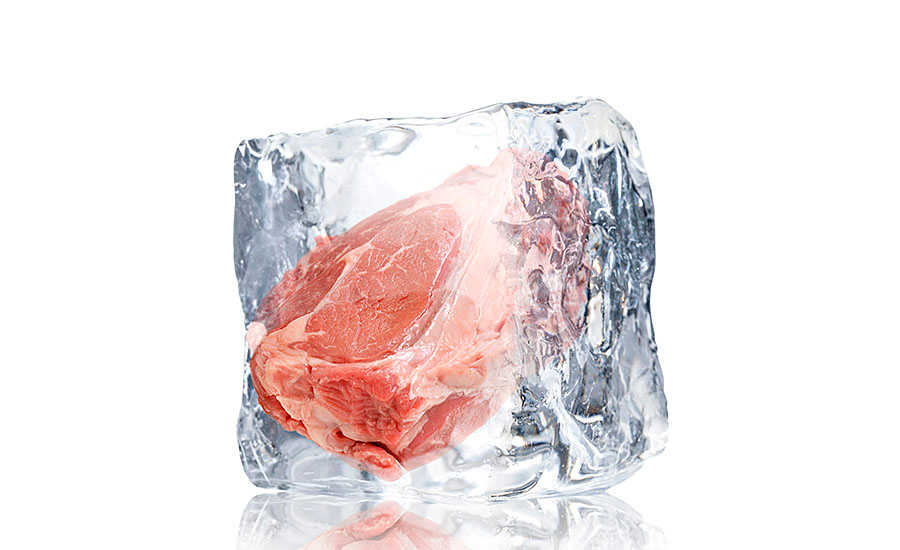Processing Tech
Freezing, chilling become hot topics in meat and poultry processing
Processors that leverage advanced freezing and chilling systems are in position to boost the appeal of meat and poultry, but costs remain a concern.




Cold is a hot concept in the development of meat and poultry.
Quickly freezing proteins during production leads to greater product quality and appearance and reductions in waste. Yet the inability of many processors to leverage the optimal technologies remains a major operational obstacle, analysts say.
“Rapid freezing helps to keep the meat’s integrity,” says Chris Fuller, owner and operator of Fuller Consulting, a San Diego-based small meat processor consulting firm. “The faster processors freeze meats in very low temperatures, often between minus 10 and minus 20 degrees Fahrenheit, the less damage the freezing process does to the structure of the meat.”
Quick freezing meat and poultry often takes less than an hour during production and then the proteins are “ready to either go into storage or out the door,” says Norman Marriott, emeritus professor in the College of Agriculture and Life Sciences at Virginia Polytechnic Institute and State University (Virginia Tech), in Blacksburg.
Rapid freezing enhances the state of proteins because the quicker activity results in less muscle cell rupture and the subsequent degradation of color, while limiting the loss of moisture or purge when thawing, he says.
Freezing and chilling meat and poultry more efficiently also helps operators minimize the outgrowth of spoilage bacteria while keeping production lines moving faster, says Jeff Sindelar, associate professor and extension meat specialist in the Department of Animal Science at the University of Wisconsin, in Madison.
The cost of state-of-the-art freezing and chilling technologies, which can range from hundreds of thousands dollars to more than $1 million, is limiting adoption of the equipment, Marriott says.
A Range of Possibilities
While that can change over time if expenses decline, processors still should seek the most appropriate freezing and chilling systems for their specific operations by concentrating on “what they do best,” Fuller says.
He says, for instance, “It is smart for operators that focus exclusively on frozen product for retail or food service to invest strongly in the best freezing technologies. It is unlikely, however, that processors of fresh proteins will see a strong return on investment if they are freezing meats just to extend the shelf life.”
Because proteins vary in chemical properties, water and fat content, fat quality, dimensions and overall mass, the various meat and poultry cuts can have different outcomes when undergoing freezing and cooling, Sindelar says.
It is important for processors to consider how specific meat and poultry align with freezer capacities, the different types and amounts of refrigerants, temperatures, heat-transfer rates and air velocities when considering technologies.
Sindelar says one of the major operational challenges is knowing how products will respond to various procedures and ensuring there is enough room on plant floors to house and operate newer equipment designs. Processors can speak with technology manufacturers and engineers to help determine the most favorable options, he says.
“The equipment is not small and can take up a lot of square footage,” Sindelar says. “It is common for processors to spend large amounts to retrofit facilities.”
More technology suppliers, however, are developing machinery with smaller dimensions that can handle larger quantities of meat and poultry and freeze proteins faster, Marriott says.
Yet, many smaller firms lack the processing volume to justify the expense of the newer designs, he says.
Instead, such operators may situate proteins in rooms with colder temperature and rapid air movement to speed up the freezing process, Marriott says, while others will place meat in a freezer “and let it freeze the conventional way. But that approach, with longer freezing times, will result in greater weight loss along with more muscle cell damage, he says.
Though all cuts can be quick frozen, operators often use a crust freeze, or quick chill, on turkey, chicken and some pork cuts, particularly pork and turkey sausage, Marriott says. Crust freeze proteins typically are just frozen on the outside and thaw in the meat case, he says.
Weigh the Cost for Cold
Processors opting for simple freezer storage, meanwhile, still can enhance performance by using perforated boxes and avoiding the stacking of pallets to allow cold air to circulate through boxes quicker, Fuller says.
“Anything an operator can do to increase the air flow around the meat, and decrease the insulating components of stacked pallets and cardboard, will help to freeze meat faster,” he says. “Speed and temperature are the keys.”
The ability to freeze and chill proteins quickly is enabling Schweid & Sons — a Carlstadt, N.J.-based ground-beef purveyor with plants in Carlstadt and College Park, Ga. — to more efficiently control its cold supply chain, says Jamie Schweid, president and chief executive officer.
“Keeping meat temperature within the critical control points is paramount to maintaining freshness, flavor and shelf life, and the ability to swiftly move the temperature lower helps mitigate any potential quality issues,” he says. “Temperature is the most important aspect of making the very best burgers.”
Schweid & Sons uses different types of freezing and chilling systems at different points in the production process. They include mixer grinders with a nitrogen injection system that chills the meat to maintain the proper temperature during blending and an ammonia-based individually quick-freezing (IQF) tunnel for freezing patties.
Schweid agrees that it is crucial for processors to consider the available space in facilities when deciding on freezing and chilling technologies for their plants.
“That could determine, for instance, if a spiral or a tunnel freezer is the right fit for the layout,” he says.
The amount of available capital also will greatly affect technology selection, Schweid says. Decisions, he says, may center on choosing an ammonia tunnel, which has significant upfront equipment costs but a dramatically lower cost of freezing over time, or a system involving nitrogen, which has a much lower upfront cost than ammonia, but a much higher per-pound cost when freezing.
“It is important for companies to research the full costs of maintaining the different systems,” Schweid says.
Processors should study the return on investment of a project over three and five years and not the traditional return-on-investment (ROI) metrics in making their technology purchasing decisions, he says.
“There will always be a cost to freeze or chill but how much a company invests in the beginning of the project can significant alter the future cost of goods,” Schweid says.
Favorable for Higher-Functioning Tech
Some meat and poultry processors still rely on lower-price conventional cold storage freezers which are not equipped to freeze meat at the optimal speed and temperatures, resulting lower-quality products, Fuller says.
Some operators who cannot afford state-of-the-art systems also are using high fan speeds and large cooling units “to increase the flow of very cold air to ‘blast’ freeze packaged products,” he says.
Fuller adds, however, that over the next few years there will likely be more affordable and more advanced options available, including more compact units.
“Smaller machine footprints and lower-cost manufacturing technologies may lead to more investment from smaller operators in newer equipment,” Fuller says. NP
Looking for a reprint of this article?
From high-res PDFs to custom plaques, order your copy today!











